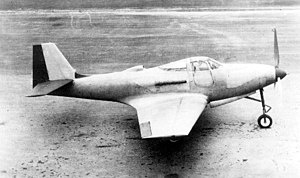
The Bell P-59 Airacomet is a single-seat, twin jet-engine fighter aircraft that was designed and built by Bell Aircraft during World War II. It was the first jet produced in the United States. As the British were further along in jet engine development, they donated an engine for the United States to copy in 1941 that became the basis for the General Electric J31 jet engine used by the P-59 a year later. Because the plane was underpowered, the United States Army Air Forces (USAAF) was not impressed by its performance and canceled half of the original order for 100 fighters, using the completed aircraft as trainers. The USAAF would instead go on to select the Lockheed P-80 Shooting Star as its first operational jet fighter. Although no P-59s entered combat, the aircraft paved the way for later generations of U.S. turbojet-powered aircraft.

The Bell P-39 Airacobra is a fighter produced by Bell Aircraft for the United States Army Air Forces during World War II. It was one of the principal American fighters in service when the United States entered combat. The P-39 was used by the Soviet Air Force, and enabled individual Soviet pilots to score the highest number of kills attributed to any U.S. fighter type flown by any air force in any conflict. Other major users of the type included the Free French, the Royal Air Force, and the Italian Co-Belligerent Air Force.

The Bell P-63 Kingcobra is an American fighter aircraft that was developed by Bell Aircraft during World War II. Based on the preceding Bell P-39 Airacobra, the P-63's design incorporated suggestions from P-39 pilots and was superior to its predecessor in virtually all respects. The P-63 was not accepted for combat use by the United States Army Air Forces. However, it was used during World War II by the Soviet Air Force, which had also been the most prolific user of the P-39.
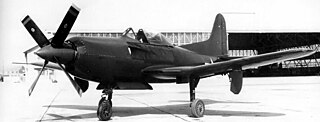
The Ryan XF2R Dark Shark was an American experimental aircraft built for the United States Navy that combined turboprop and turbojet propulsion. It was based on Ryan Aeronautical's earlier FR Fireball, but replaced the Fireball's piston engine with a turboprop engine.

The Curtiss-Wright XP-55 Ascender is a 1940s United States prototype fighter aircraft built by Curtiss-Wright. Along with the Vultee XP-54 and Northrop XP-56, it resulted from United States Army Air Corps proposal R-40C issued on 27 November 1939 for aircraft with improved performance, armament, and pilot visibility over existing fighters; it specifically allowed for unconventional aircraft designs. An unusual design for its time, it had a canard configuration with a rear-mounted engine, and two vertical tails at end of swept wings. Because of its pusher design, it was satirically referred to as the "Ass-ender". Like the XP-54, the Ascender was designed for the 1,800 hp Pratt & Whitney X-1800 24-Cylinder H-engine, but was redesigned after that engine project was canceled. It was also the first Curtiss fighter aircraft to use tricycle landing gear.

The Bell XFL Airabonita was an American experimental carrier-based interceptor aircraft developed for the United States Navy by Bell Aircraft Corporation of Buffalo, New York. It was similar to and a parallel development of the U.S. Army Air Corps’ land-based P-39 Airacobra, differing mainly in the use of a tailwheel undercarriage in place of the P-39's tricycle gear. Only one prototype was built.

The Bell XP-77 development was initiated by the United States Army Air Forces during World War II to produce a simplified "lightweight" fighter aircraft using non-strategic materials. Despite being innovative, the diminutive prototype proved tricky to handle and the project was canceled when the XP-77 did not deliver its projected performance.

The Curtiss XP-46 was a 1940s American prototype fighter aircraft. It was a development of the Curtiss-Wright Corporation in an effort to introduce the best features found in European fighter aircraft in 1939 into a fighter aircraft which could succeed the Curtiss P-40, then in production.

The Curtiss P-60 was a 1940s American single-engine single-seat, low-wing monoplane fighter aircraft developed by the Curtiss-Wright company as a successor to their P-40. It went through a lengthy series of prototype versions, eventually evolving into a design that bore little resemblance to the P-40. None of these versions reached production.

The Curtiss XP-62 was a prototype single-engine interceptor aircraft, that was built for the United States Army Air Forces, by the Curtiss-Wright Corporation. It first flew in 1943.

The Fisher P-75 Eagle was an American fighter aircraft designed by the Fisher Body Division of General Motors. Development started in September 1942 in response to United States Army Air Forces requirement for a fighter possessing an extremely high rate of climb, using the most powerful liquid-cooled engine then available, the Allison V-3420. The program was cancelled after only a small number of prototypes and production aircraft had been completed, as it was no longer required in its original role, could not be quickly deployed, and possessed no significant advantages over aircraft already in production.

The McDonnell XP-67 "Bat" or "Moonbat" was a prototype for a twin-engine, long-range, single-seat interceptor aircraft for the United States Army Air Forces. Although the design was conceptually advanced, it was beset by numerous problems and never approached its anticipated level of performance. The project was cancelled after the sole completed prototype was destroyed by an engine fire.
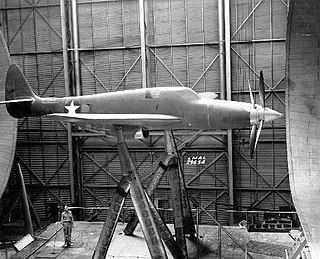
The Republic XP-69 was an American fighter aircraft proposed by Republic Aviation in 1941 in response to a requirement by the United States Army Air Corps for a high-speed fighter. Manufacturers were encouraged to consider unorthodox designs; although the design was ordered as a prototype it was canceled because of delays with the engine that was to power it.

The Vultee XP-54 Swoose Goose was a prototype fighter built by the Vultee Aircraft Company for the United States Army Air Forces (USAAF).
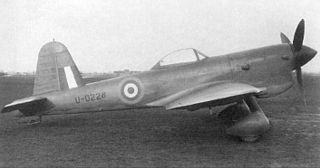
The Miles M.20 was a Second World War British fighter developed by Miles Aircraft in 1940. It was designed as a simple and quick-to-build "emergency fighter" alternative to the Royal Air Force's Spitfires and Hurricanes should their production become disrupted by bombing expected in the anticipated German invasion of the United Kingdom. Due to the subsequent shifting of the German bombing effort after the Battle of Britain towards British cities in what became known as The Blitz, together with the dispersal of British fighter manufacturing, the Luftwaffe's bombing of the original Spitfire and Hurricane factories did not seriously affect production, and so the M.20 proved unnecessary and the design was not pursued.

The Curtiss SC Seahawk was a scout seaplane designed by the Curtiss Aeroplane and Motor Company for the United States Navy during World War II. The existing Curtiss SO3C Seamew and Vought OS2U Kingfisher were gradually replaced by the Seahawk in the late stages of the war and into peacetime.

The Bell YFM-1 Airacuda was an American heavy fighter aircraft, developed by the Bell Aircraft Corporation during the mid-1930s. It was the first military aircraft produced by Bell. Originally designated the Bell Model 1, the Airacuda first flew on 1 September 1937. The Airacuda was marked by bold design advances and considerable flaws that eventually grounded the aircraft.

The Curtiss XP-42 was an experimental fighter built by Curtiss Aircraft in the late 1930s to research engine cooling and improving the performance of the Curtiss P-36 Hawk.

The Piaggio P.119 was an Italian experimental fighter of World War II. It had a relatively novel layout, with a "buried" radial engine mounted mid-fuselage. Only a single prototype was built before the Armistice between Italy and the allied armed forces, which ended the project.
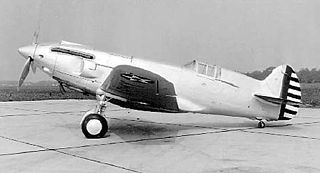
The Curtiss P-37 was an American fighter aircraft made by Curtiss-Wright in 1937 for the US Army Air Corps. A development of the Curtiss P-36 Hawk to use an inline engine instead of the radial engine of the P-36 the fuselage was lengthened and the cockpit moved back. A small number of YP-37 aircraft was built for Air Corps evaluation. The expected top speed was not achieved and the project terminated in favor of the Curtiss P-40.
